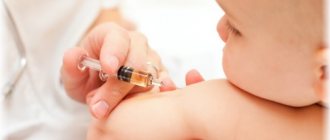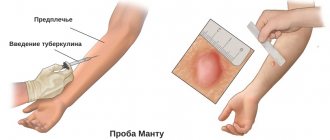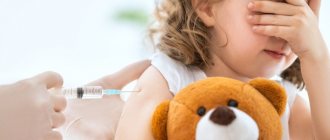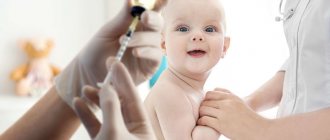When not to vaccinate
Vaccinations play a large role in the formation of acquired immunity against infectious diseases.
After vaccination, a person's immune system begins to produce antibodies to fight the infection. If in the future the body encounters the causative agent of this disease, the immune system will turn on its protective reaction and will not give it a chance. However, vaccinations, on the one hand, do not provide a 100% guarantee, and, on the other hand, they are fraught with complications. But the degree of protection against infection can be increased, and complications can be prevented. And here a strong immune system plays a major role.
A child who has a weakened immune system should not be vaccinated. If the baby has recently been sick or someone close to you in the family is sick, then you need to wait a bit with the vaccination. In addition, it is necessary to make sure in advance that there are no parasites in the body, since a parasitic infection significantly reduces the effectiveness of the vaccine and provokes the development of complications after vaccinations .
How to strengthen your immune system
What does the state of immunity depend on? As you know, 70% of immune cells are located in the intestines. Thus, the state of immunity depends primarily on the integrity and normal functioning of the intestinal biofilm and all mucous membranes of the human body. [1]
Biofilm can be created by taking probiotics - preparations containing bifidobacteria and lactobacilli. An organism with a complete biofilm independently copes with diseases and prevents complications after vaccinations.
To create a biofilm and effectively correct microflora, the drug “Bifidum BAG” is used. It completely restores the intestinal biofilm. The content of bifidobacteria in this preparation is very high - 1012 beneficial bacteria are found in 1 ml. "Bifidum BAG" can be used in the first days of life.
How to prepare for vaccination
- Children's vaccinations should be carried out individually, taking into account the health status of the individual child.
- A few days before vaccination, it is necessary to do a general blood and urine test to ensure that the baby is in normal health.
- If a child has a predisposition to allergies, then you should discuss with your doctor in advance a plan for preventing exacerbation of an allergic reaction to vaccination.
- Before vaccination, you should not add new types of food to your child’s menu - this may lead to unexpected reactions.
- To prevent complications from vaccinations, it is necessary to give children a complex of probiotics (Bifidum BAG, Trilact, Ecoflor) 2-5 days before vaccination and 3-14 days after vaccination. The duration of treatment depends on the risk group to which the baby belongs (healthy, allergic, frequently ill child, etc.). "Bifidum BAG" can be given to a child from birth, "Trilact" - from 1 year, "Ecoflor" - from 3 years.
- Before the vaccination itself, the doctor must make sure that the child does not have a fever at the time of vaccination.
- After vaccination, the child should sit for 30-40 minutes in the clinic. This will allow you to provide quick help in case of an allergic reaction.
- If a child has a fever on the first night after vaccination, it is necessary to give the child an antipyretic drug and be under the supervision of a doctor in the next 24 hours.
Scientists have proven: the stronger the immunity of the person being vaccinated, the higher the effectiveness of the vaccination and the less likely there are complications after it. A biofilm created using a biocomplex (“Bifidum BAG”, “Trilact”, “Ecoflor”) will provide a high level of body resistance, activating its protective properties.
[1]
What is biofilm?
Biofilm is a layer of beneficial bacteria closely associated with each other. The biofilm is attached to the epithelial villi, epithelial cells that provide the integrity, structure and function of the mucous membranes. It is a solid foundation for the formation of immune, hematopoietic, protective, absorption, vitamin-forming, enzymatic and hormonal functions, and actively suppresses the growth of pathogenic bacteria, viruses and fungi.
How to relieve pain during vaccination
Authors : American Academy of Pediatrics
To make the administration of vaccines less painful, doctors can use some tricks or, in modern terms, life hacks: change the order of drug administration, use the calming influence of parents, in parallel with the vaccination, ask the mother to breastfeed the child... You can also regularly use a local anesthetic - this concerns pain relief from intramuscular injection in patients of all ages.
This is exactly what is discussed in the new clinical practice guideline, authored by Anna Taddio, an employee of the University of Toronto, Ontario, Canada, as well as 24 other experts from the interdisciplinary medical group HELPinKids&Adults.
“None of the recommended interventions can completely eliminate pain from intramuscular injection (i.e., reach a level of “zero” on a pain scale of ten). In some cases, it makes sense to use several pain-relieving techniques at once to achieve a minimum of discomfort from a mandatory but unpleasant procedure,” advise Dr. Taddio and her co-authors.
HELPinKids&Adults experts argue that fear of pain caused by vaccination can significantly reduce the desire for vaccination not only in children, but also in adults. Therefore, the team developed a comprehensive approach to reducing pain during vaccination, which includes the use of physical, pharmacological, psychological and technological methods to reduce pain.
Researchers recommend that when vaccinating intramuscular patients of all ages, doctors do not hold the needles in the tissue longer than necessary and do not move the syringe from side to side, as this can increase pain. The guidelines also advise administering the most painful vaccine to patients of any age last. Such drugs include: pneumococcal conjugate vaccine, hepatitis B vaccine, human papillomavirus vaccine, etc.
In addition, scientists have shown that maternal affection and the sweet taste of breast milk can reduce pain in children, so the authors strongly recommend breastfeeding immediately after vaccinations in children under two years of age.
For children under 2 years of age who are not breastfed, it is recommended to give 2 ml of a 24–50% sucrose solution immediately before the administration of vaccines (no more than 2 minutes before the injection). For example, the oral rotavirus vaccine should be given first because it contains sucrose.
Children under 3 years of age should be placed in a comfortable position during vaccinations, and newborns who are not breast-fed should have skin-to-skin contact with the parent.
Whenever possible, the patient should sit while the vaccine is being administered because sitting gives the person a sense of control and reduces fear.
The ideal situation would be when, when vaccinating children under 10 years of age, parents are directly next to the child and know how to help him cope with fear before and during vaccination (it is advisable to discuss these issues with the doctor and the child in advance).
On the day of vaccination, children over the age of 3 years should be told in advance that vaccination is planned, how many injections will be, in what places, how the child may feel, and what the doctor and/or parents will do to relieve their pain. Lying - both from parents and medical professionals - should be excluded, since it breeds mistrust and dramatically increases fear and pain in the child.
According to Robert Virgin, who practices as a family physician in his hometown of Milford, Nebraska, these recommendations are quite logical and are confirmed by his practice. Dr. Virgin always saves the most painful injection for last, invites parents in advance and conducts workshops with them on pain relief for children. He also suggests breastfeeding or sucrose when vaccinating or circumcising boys. “None of these recommendations can harm the patient. However, full compliance with them by doctors will increase the appointment time and its cost,” sums up the practitioner.
True, he does not unconditionally agree with all the advice. For example, it is recommended that a local anesthetic be used before the vaccine for all children under 12 years of age, which should be applied 30 minutes before the injection. Dr. Virgin believes that only some patients actually need local anesthesia before the injection: “Pain is an inevitable and necessary part of our lives, and most children cope with it relatively well.”
So, the vast majority of recommendations from this clinical guideline should not cause rejection on the part of doctors, do not require additional costs and are fully consistent with the principles of caring for the patient, especially a child, on the part of doctors.
Source
published 08/08/2018 08:00 updated 23/09/2019 — Vaccination, Vaccination
Calendar of preventive vaccinations for children under 7 years of age
| Age | Name of vaccination |
| 1st day | First vaccination against viral hepatitis B |
| 3-7 days | First vaccination against tuberculosis |
| 1 month | Second vaccination against hepatitis B |
| 3 months | First vaccination against whooping cough, diphtheria, tetanus |
| 3 months | First polio vaccination |
| 3 months | First vaccination against Haemophilus influenzae |
| 4.5 months | Second vaccination against whooping cough, diphtheria, tetanus |
| 4.5 months | Second polio vaccination |
| 4.5 months | Second vaccination against Haemophilus influenzae |
| 6 months | Third vaccination against whooping cough, diphtheria, tetanus |
| 6 months | Third polio vaccination |
| 6 months | Third vaccination against Haemophilus influenzae |
| 6 months | Third vaccination against hepatitis B |
| 1 year | First vaccination against measles, mumps, rubella |
| 18 months | First revaccination against whooping cough, diphtheria, tetanus |
| 18 months | First revaccination against polio |
| 20 months | Second revaccination against polio |
| 6 years | Revaccination against measles, rubella, mumps |
| 6-7 years | Third revaccination against diphtheria, tetanus |
.
Vaccination calendar
| Child's age | Name of preventive vaccination |
| Newborns in the first 24 hours of life | First vaccination against viral hepatitis B |
| Newborns on days 3-7 of life | Vaccination against tuberculosis |
| Children 1 month | Second vaccination against viral hepatitis B |
| Children 2 months | Third vaccination against viral hepatitis B (risk groups) First vaccination against pneumococcal infection |
| Children 3 months | First vaccination against diphtheria, whooping cough, tetanus First vaccination against polio First vaccination against Haemophilus influenzae (risk group) |
| Children 4.5 months | Second vaccination against diphtheria, whooping cough, tetanus Second vaccination against polio Second vaccination against Haemophilus influenzae infection (risk groups) Second vaccination against pneumococcal infection |
| Children 6 months | Third vaccination against diphtheria, whooping cough, tetanus Third vaccination against viral hepatitis B Third vaccination against polio Third vaccination against Haemophilus influenzae infection (risk group) |
| Children 12 months | Vaccination against measles, rubella, mumps Fourth vaccination against viral hepatitis B (risk groups) |
Contraindications for vaccination are: severe reaction to previous vaccine administration, current acute diseases, malignant disease or the presence of immunodeficiency, severe chronic diseases in the acute stage.
Some vaccinations require revaccination - repeated administration of the vaccine to consolidate acquired immunity. This procedure should not be avoided; it will help the baby better resist diseases.










